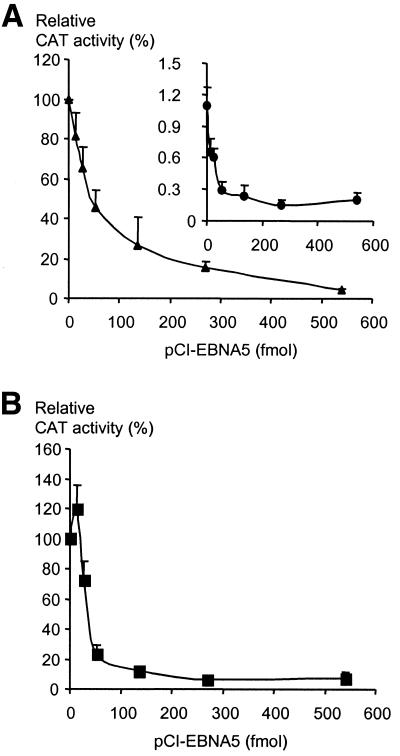Figure 1.
Effect of EBNA5 on constitutive and EBNA2-induced expression of LRS-containing reporter plasmids. (A) The EBV-negative B cell line DG75 (5 × 106 cells) was transfected with the pgLRS(–634)CAT reporter plasmid together with the EBNA2 expression vector pEΔA6 (main panel) or with an equivalent amount of the empty vector pSV2gpt (inset) and increasing amounts of the EBNA5 expression vector pCI-EBNA5. The CAT activity is given as relative chloramphenicol acetylation expressed as a percentage of the activity obtained with pgLRS(–634)CAT in the presence of EBNA2 and in the absence of EBNA5. The 100% value corresponds to acetylation of 260% of the substrate in the assay (measured value × dilution factor). The values shown are the mean of five independent experiments. Error bars indicate standard errors of the mean (SEM). Variations in the amount of expression vector were compensated for by the addition of appropriate molar amounts of pCI or pSV2gpt DNA to the transfection mixtures. (B) The pgLRS(–54)CAT reporter plasmid was transfected together with increasing amounts of the EBNA5 expression vector pCI-EBNA5 into 5 × 106 DG75 cells (constitutive expression). The CAT activity is given as relative chloramphenicol acetylation expressed as a percentage of the activity obtained with pgLRS(–54)CAT in the absence of EBNA5. The 100% value corresponds to acetylation of 110% of the substrate in the assay (measured value × dilution factor). The mean values ± SEM of five independent experiments are presented. Variations in the amount of expression vectors were compensated for by addition of the appropriate molar amounts of pCI to the transfection mixtures.

